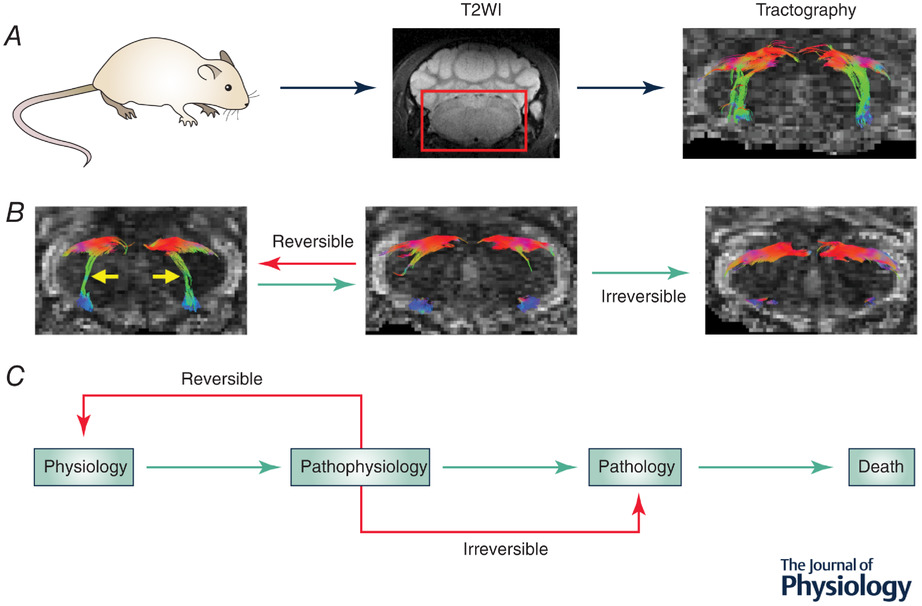蔡靜宜 副研究員
中樞心血管調控
訊息傳遞
分子影像
殺蟲劑、麻醉劑之藥理學
氧化還原訊息與氧化壓力
- 聯絡電話
(07) 731-7123 ext 8598
- 電子郵件信箱
cytsai@cgmh.org.tw
個人簡介
研究主軸: 解開腦幹調節心血管功能在健康和疾病模型中的細胞和分子機制
本實驗室的研究聚焦於腦幹死亡 (brainstem death),神經源性高血壓 (neurogenic hypertension) 和肝性腦病變 (hepatic encephalopathy) 等疾病模式腦幹心血管調控中所涉及的訊息傳遞路徑和神經迴路探討。我們的研究是使用臨床相關的動物模型,並將細胞和分子生物學整合到系統生理學中來進行。近年來,我們亦將腦幹心血管調節的研究視野擴展到感壓反射神經迴路中所涉及到的腦幹核區之間功能性連結的圖像變化,並表明這些變化具有生理學和病理學上的意義。
1. 提出延腦腹外側核 (RVLM) 在有機磷美文松中毒引起的腦幹死亡模型中的細胞分子機制。
我們的研究發現RVLM內PI3K/Akt訊息路徑活化會導致NF-κB/NOS II/peroxynitrite路徑進一步活化並造成腦幹心血管調控失能。FLJ10540為PI3K結合蛋白,可以促進PI3K/Akt訊息傳遞路徑引起心血管調控失能。另一方面,PTEN可以透過減少本身的氧化態來增進活性,並扮演PI3K/Akt訊息路徑的負調控者來抑制下游的NOS II/peroxynitrite路徑,進而減緩心血管調控失能。(Biochem Pharmacol. 2018 Sep; 155:207-212.)

2. 我們還將分子影像與腦幹心血管調節的生理評估相結合,使用磁振擴散張量影像 (DTI) 來檢測感壓反射神經迴路中涉及的腦幹核區之間的功能性連結變化。
在病理生理條件下 (例如神經源性高血壓),此神經迴路連結中斷,產生高血壓。當神經連結中斷可逆轉,血壓回復正常值,代表此疾病模式可以被治療。然而,當病理生理狀況演變為病理狀態時 (例如肝性腦病變),此神經連結中斷不可逆轉,最後動物死亡,代表此疾病模式不可以被治療。(J Physiol. 2019 Jan; 597(1):41-55.)

代表著作
Selected recent publications (Pubmed Search)
(† Contributed equally to the article; * Correspondence author of the article)
- Tsai CY*, Fang C, Wu JCC, Wu CJ, Dai KY, Chen SM. Neuroinflammation and microglial activation at rostral ventrolateral medulla underpin cadmium-induced cardiovascular dysregulation in rats. Journal of Inflammation Research 14, 3863-3877 (2021).
- Poon YY†, Tsai CY†, Huang YH, Wu JCC, Chan SHH, Chan JYH. Disproportional cardiovascular depressive effects of isoflurane: Serendipitous findings from a comprehensive re-visit in mice. Lab Anim (NY) 50, 26-31 (2021).
- Tsai CY*, Wu CJ, Wu JCC, Fang C, Huang YH, Dai KY. Redox-active DJ-1 sustains brainstem cardiovascular regulation via maintenance of mitochondrial function during mevinphos intoxication. Neurochem Int 139, 104791 (2020).
- Chen SM, Phuagkhaopong S, Fang C, Wu JCC, Huang YH, Vivithanaporn P, Lin HH, Tsai CY*. Dose-dependent acute circulatory fates elicited by cadmium are mediated by differential engagements of cardiovascular regulatory mechanisms in brain. Frontiers in Physiology 10, 772 (2019).
- Tsai CY, Poon YY, Chan JYH, Chan SHH. Baroreflex functionality in the eye of diffusion tensor imaging. The Journal of Physiology 597, 41-55 (2019).
- Tsai CY*, Dai KY, Fang C, Wu JCC, Chan SHH*. PTEN/FLJ10540/PI3K/Akt cascade in experimental brain stem death: A newfound role for a classical tumorigenic signaling. Biochemical Pharmacology, 155, 207-212 (2018).
- Tsai CY*, Wu JCC, Fang C, Chang AYW. PTEN, a negative regulator of PI3K/Akt signaling, sustains brain stem cardiovascular regulation during mevinphos intoxication. Neuropharmacology 123: 175-185 (2017).
- Tsai CY, Su CH, Chan JYH, Chan SHH*. Nitrosative stress-induced disruption of baroreflex neural circuits in a rat model of hepatic encephalopathy: a DTI study. Scientific Reports, 7: 40111 (2017).
- Tsai CY, Li FCH, Wu CHY, Chang AYW*, Chan SHH*. Sumoylation of IκB attenuates NF-κB-induced nitrosative stress at rostral ventrolateral medulla and cardiovascular depression in experimental brain death. Journal of Biomedical Science, 23: 65 (2016).
- Tsai CY†, Chen CH†, Chang AYW, Chan JYH, Chan SHH*. Upregulation of FLJ10540, a PI3K-association protein, in rostral ventrolateral medulla impairs brain stem cardiovascular regulation during mevinphos intoxication. Biochemical Pharmacology, 93: 34-41 (2015).
研究團隊
吳嘉琦
李真來
蔡秀玟
學術履歷
Education:
2009 Ph.D. Department of Biological Sciences, National Sun Yat-sen University, Kaohsiung, Taiwan
2004 B.S. Department of Biological Sciences, National Sun Yat-sen University, Kaohsiung, Taiwan
Professional Experience:
2019/8 ~ present Associate Professor, Institute for Translational Research in Biomedicine, Kaohsiung Chang Gung Memorial Hospital, Kaohsiung, Taiwan
2015/9 ~ 2019/7 Assistant Professor, Institute for Translational Research in Biomedicine, Kaohsiung Chang Gung Memorial Hospital, Kaohsiung, Taiwan
2009/9 ~ 2015/8 Postdoctoral Research Fellow, Institute for Translational Research in Biomedicine, Kaohsiung Chang Gung Memorial Hospital, Kaohsiung, Taiwan
Awards and Honors:
2019 Editorial Board Fellow, The Journal of Physiology
2018 Awardee, Chang Gung Outstanding Young Medical Researcher Award, Chang Gung Medical
Foundation, Kaohsiung, Taiwan (長庚醫學研究獎-青年獎)
2016 Awardee, Young Investigator Award, Federation of Asian Societies for Molecular Imaging (FASMI) Annual Meeting, Kobe, Japan
2016 Travel Grants and Oral Speaker, the 13th Asia Pacific Federation of Pharmacologists (APFP) Meeting, Bangkok, Thailand
2013 Awardee, Outstanding Young Scientist Oral Presentation Award, the 12th meeting of the Asia Pacific Federation of Pharmacologists (APFP), Shanghai, China
2008 Awardee, Distinguished Postgraduate Student Research Award, the Pharmacological Society in Taiwan, Taiwan
2007 1st prize, SEAWP Poster Prize, the 10th Southeast Asian Western Pacific regional meeting of Pharmacologists (SEAWP), Adelaide, Australia
2006 Participant, the 9th International Brain Research Organization-Asia Pacific Regional Committee (IBRO-APRC) School of Neuroscience, Hong Kong, China
Professional Activities:
2021~ Associate Editor, Natural Sciences
2019 Symposium Organizer and Chair, the 9th Federation of the Asian and Oceanian Physiological Societies Congress (FAOPS2019), Kobe, Japan
2018~ Editorial Board, FASEB BioAdvances
2017 Invited Speaker, Young Investigator Colloquium, the International Society for Neurochemistry (ISN) 2017 Biennial Meeting, Paris, France
2014 Invited Speaker, Young Investigator Colloquium, the 12th meeting of the Asian Pacific Society for Neurochemistry (APSN), Kaohsiung, Taiwan
2012 Invited Speaker, Young Investigator Colloquium, the 11th meeting of the Asian Pacific Society for Neurochemistry (APSN), Kobe, Japan
Professional Societies:
American Physiological Society (APS)
International Society for Neurochemistry (ISN)
The Chinese Physiological Society
The Pharmacological Society in Taiwan
Research Interests:
- Central Cardiovascular Regulation
- Signal Transduction
- Molecular Image
- Pharmacology of pesticides and anesthetics
- Redox signaling and oxidative stress
